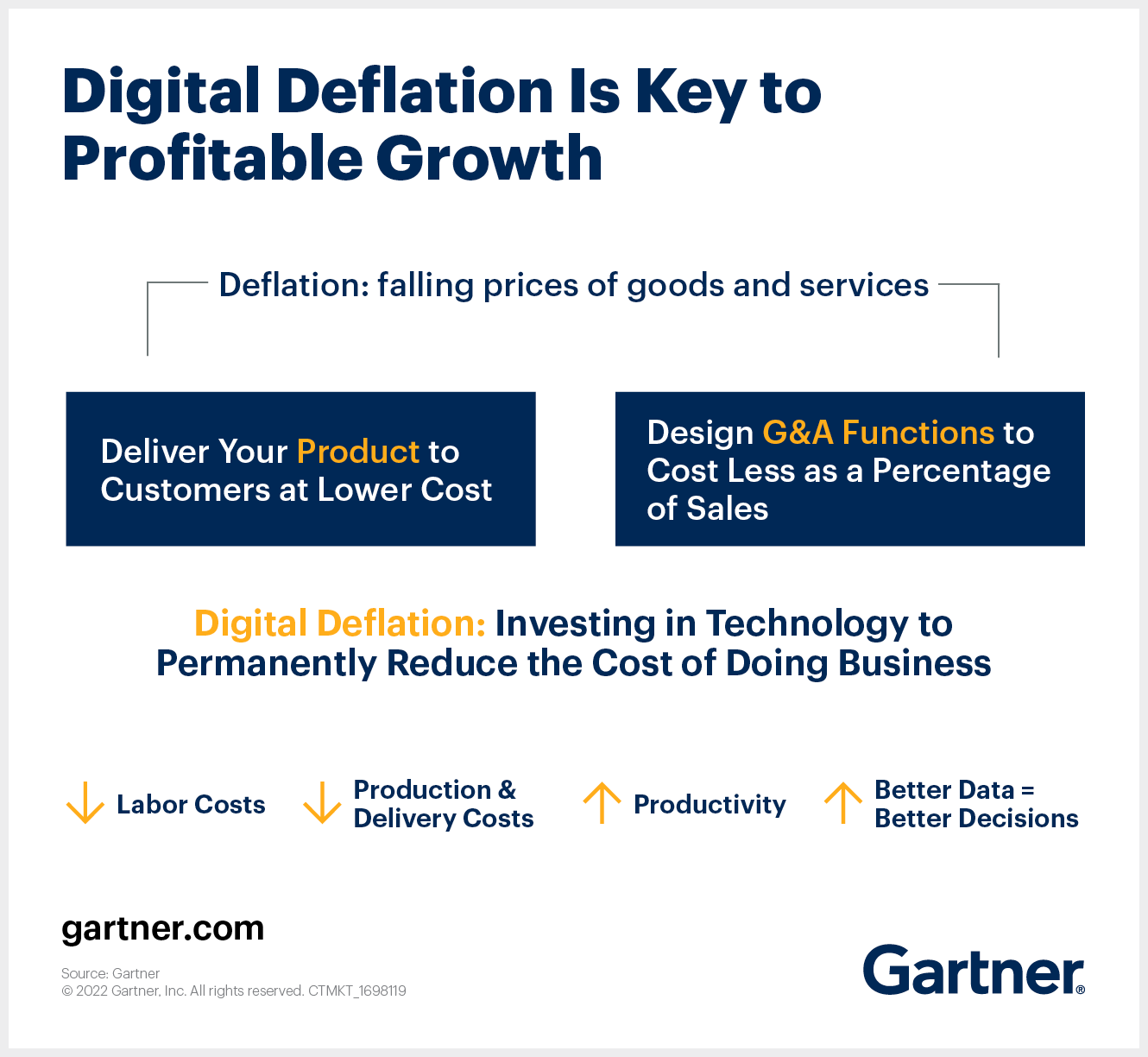09 March 2022
- Gartner client? Log in for personalized search results.
CFOs, Use Technology in Your Inflation Fight
Contributor: Rob van der Meulen
Investing in technology in the face of inflation, not scaling back, can reduce the cost of doing business.
In short:
- Inflation is at multiyear highs, which can drive lower profitability in organisations, leading many CFOs to look for costs to cut or delay.
- Yet scaling back on digital transformation initiatives in the face of inflation is the wrong approach.
- Leading digital organisations have a lower cost of doing business and thus a significant competitive advantage in the current inflationary environment.
In 2021, 60% of organisations were experiencing wage inflation. Since then, mentions of inflation on earnings calls have increased eightfold. There is little question that inflation will be a big theme in 2022 or that it will present challenges.
“CFOs have little control over inflation itself, but it adds cost pressure that they must navigate their businesses through,” says Alexander Bant, Practice Vice President, Finance at Gartner. “When faced with challenges that could harm profitability, the instinctive CFO response is to reduce costs near-term or delay spending until inflation subsides.”
Download now: Emerging Trends and Next Steps for CFOs and Finance Leaders
In a recent Gartner survey, 74% of CFOs ranked profitability as their top concern, the highest of any inflation impact. In many areas, the instinctive approach to control costs will be the right one to mitigate inflationary margin pressures. Simply trying to spend your way out of inflation is not going to work.
However, digital initiatives should be seen through a different lens. Well-planned and implemented digital initiatives must have a long-term deflationary effect on business costs and, subsequently, the price of products or services.
“We call this digital deflation—investing in technology to permanently reduce the cost of doing business,” says Bant.
Digital investment is not the only way that you can mitigate inflationary pressures, but it may be a route you have not considered. Gartner experts recommend a two-pronged approach to this:
- Continue to fund the right digital enterprise growth bets, even if margins seem tight.
- Apply technology to deflate the cost of finance.
Continue to place long-term bets when funding the enterprise digital strategy
“CFOs must try to lead the C-suite to drive a unified enterprise digital strategy,” says Bant. “Inflation can be a catalyst for organisations to drive key digital and cost reduction initiatives across the whole business.”
When thinking about how to fund digital bets in an inflationary environment, it is key to avoid traditional, rigid funding models that prevent flexible resource allocation. Do as activist investors do and regularly assess the organisation’s value creation strategy, divest business lines to bring the portfolio in line with a coherent vision and drive down the costs of products or services.
It is vital to fix systemic data governance and literacy issues across the entire business to maximise the effectiveness of digital bets. Select the right metrics to assess digital initiatives across their entire life cycle to fully understand their impact.
An important last measure: explain your digital initiatives to investors in terms of a digital inflation story. Leverage the right metrics to show how you will reduce costs near-term while driving costs out long-term with digital investments.
How to deflate the cost of finance
“It is important to have a methodology to predict finance spend, such as the Gartner Cost Curves™, to put together a digital deflation plan,” says Bant. “Once the key drivers of cost in the finance function are understood, you will clearly see the areas to focus your attention on.”
Our experts have identified key focus areas to cut costs for a typical finance function:
- Streamline processes via automation, which is vital to digital deflation efforts and allows the finance team to focus its efforts on high-value work and increased productivity.
- Shift the right work to business process outsourcing (BPO) providers to reduce expensive labour costs.
- Leverage machine learning and artificial intelligence (AI) to get the most out of your organisational data and improve predictive business insights.
- Hire the right digital talent that aligns to your digital transformation efforts.
- Select vendors that will help scale products and meet customer expectations.
Gartner CFO & Finance Executive Conference
Join CFOs and finance executives to learn how to navigate emerging trends and challenges. From peer-led sessions to analyst one-on-ones, you'll leave ready to tackle your mission-critical priorities.
Recommended resources for Gartner clients*:
How to Account for Inflation Uncertainty When Providing Financial Guidance
How to Mitigate Margin Pressure From Input Price Inflation
*Note that some documents may not be available to all Gartner clients.
